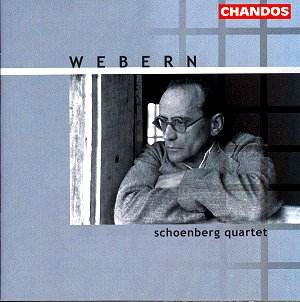The
Schoenberg Quartet continues its traversal of the chamber music
of the Second Viennese School (plus certain of their contemporaries)
with this very well filled survey of the music of Anton Webern.
Having found their Berg disc to be rather cool and under-powered
for some of that composer’s overheated textures, it’s good to
report a much more satisfying result here.
To
have all this music on one single disc makes this excellent value
anyway, regardless of quality of performance. There are other
good discs of Webern’s chamber music, but none are as comprehensive
as this. It gives the listener a virtually complete picture of
the composer’s output, from the early Romantic pieces right through
to his maturity. The posthumously published works are well worth
hearing, even if the composer himself disregarded them and may
well have been uneasy about them being included. In fact the longest
work on the disc is the String Quartet from 1905 which,
at over 17 minutes, is one of the longest pieces in the entire
Webern canon! Its lush harmonies and wandering melodic lines clearly
indicate an affinity with early Schoenberg (himself still under
the spell of Wagner) and one can detect Verklärte Nacht
at many turns. But though the tonal centres are clear and the
harmony recognisable, there is a hint of things to come, particularly
in the way that the main melodic motif’s angular quality signals
its serial potential.
The
gorgeous little Slow Movement from the same year has many
of the same characteristics, and here the use of the turn makes
one think directly of Tristan, even if the bitter sweet
tonality is entirely Viennese.
The
Six Bagatelles of 1911-13 begin to show the sort of thumbprints
that Webern became famous for, notably brevity of utterance and
an aphoristic style that he was to perfect over the ensuing years.
They are beautifully crafted little jewels, where the silence
between the notes becomes as important as the notes themselves.
The Schoenberg’s seem to understand this perfectly, making sure
that weight of attack is crisp and handling of texture and dynamics
is clean and clear. Most of these minuscule works last under a
minute, so every note has to count.
The
experienced pianist Sepp Grotenhuis joins in for a number of other
works, the most interesting of which seemed to me to be the Three
Little Pieces of 1914, typical Webern. Extreme brevity is
again apparent (the pieces are 9, 13 and 10 bars respectively),
but he still manages to convey emotion and feeling into his microcosmic
world.
The
Schoenberg’s utter refinement and feeling for these special textures
pay real dividends in the mature Trio and Quartet,
possibly the best known pieces (certainly the most oft-recorded)
on the disc. The Op.28 Quartet seems to inhabit a more
sober world of serialism (it became a calling card for the post-war
avant-garde), and the terse, spare movements are riddled with
codes and patterns which still make for demanding, concentrated
listening. Only in the finale do we get a feeling of longing,
of harking back to old Expressionistic tendencies, of something
approaching emotion.
The
whole disc is a great success. Recording quality is first rate,
with the necessary clarity tempered by warmth and just the right
amount of resonance. Excellent notes are by Dr. Christopher Hailey.
Recommended, even if you still find Webern hard work.
Tony
Haywood
